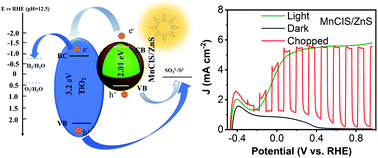Environmentally friendly Mn-alloyed core/shell quantum dots for high-efficiency photoelectrochemical cells†
Abstract
Colloidal quantum dot (QD)-based photoelectrochemical (PEC) cells are cost-effective devices showing remarkable solar-to-fuel conversion efficiency. However, the extensive use of highly toxic elements (e.g. Pb and Cd) in QDs' synthesis and device fabrication is still a major challenge towards their practical development. Herein, we fabricate a solar-driven PEC cell based on environmentally friendly Mn-alloyed CuInS2 (MnCIS)/ZnS core/shell QDs, showing more favorable band alignment, efficient charge transfer, reduced charge recombination and lower charge transfer resistance with respect to the control device fabricated using unalloyed CuInS2 (CIS)/ZnS core/shell QDs. An unprecedented photocurrent density of ∼5.7 mA cm−2 with excellent stability was obtained for the as-fabricated MnCIS/ZnS core/shell QD-based PEC device when operated under standard one sun irradiation (AM 1.5G, 100 mW cm−2). These results indicate that the transition metal-alloyed environmentally friendly core/shell QDs are promising for next-generation solar technologies.



 Please wait while we load your content...
Please wait while we load your content...